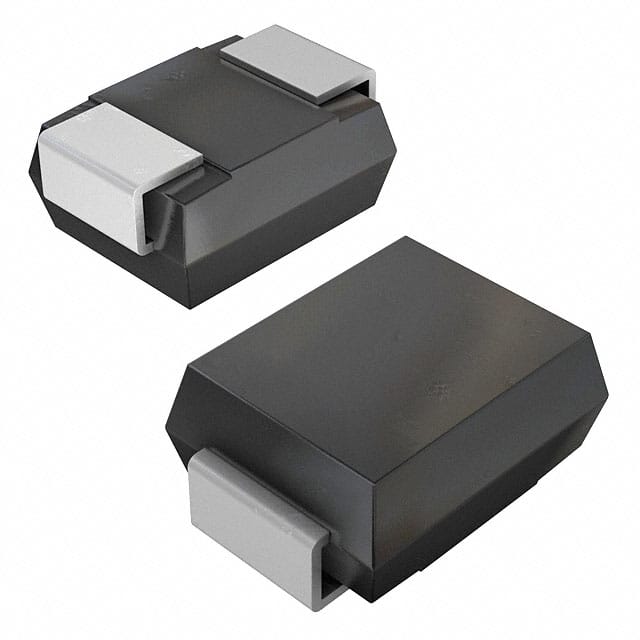1KSMB12CA
Product Overview
Category
The 1KSMB12CA belongs to the category of transient voltage suppressor (TVS) diodes.
Use
It is used to protect sensitive electronic components from voltage transients induced by lightning, electrostatic discharge (ESD), and other transient voltage events.
Characteristics
- Fast response time
- Low clamping voltage
- High surge current capability
- RoHS compliant
Package
The 1KSMB12CA is available in a DO-214AA (SMB) package.
Essence
The essence of the 1KSMB12CA lies in its ability to divert excessive current away from sensitive components, thereby safeguarding them from damage.
Packaging/Quantity
The 1KSMB12CA is typically packaged in reels or trays and is available in quantities suitable for both prototyping and production purposes.
Specifications
- Standoff Voltage: 10.5V
- Breakdown Voltage: 11.7V
- Maximum Clamping Voltage: 19.9V
- Peak Pulse Current: 30A
- Operating Temperature Range: -55°C to +150°C
Detailed Pin Configuration
The 1KSMB12CA TVS diode has two pins, anode, and cathode, which are denoted by the "+" and "-" symbols, respectively.
Functional Features
- Bi-directional clamping capability
- Low leakage current
- High reliability
Advantages and Disadvantages
Advantages
- Effective protection against voltage transients
- Fast response time
- Compact size
Disadvantages
- Limited peak pulse current handling capability compared to larger TVS diodes
- Higher clamping voltage than some specialized TVS diodes
Working Principles
When a transient voltage event occurs, the 1KSMB12CA conducts current to divert the excess energy away from the protected circuit, thus limiting the voltage across it.
Detailed Application Field Plans
The 1KSMB12CA is commonly used in: - Telecommunication equipment - Industrial control systems - Automotive electronics - Power supplies - Consumer electronics
Detailed and Complete Alternative Models
- 1KSMB6.8CA
- 1KSMB10CA
- 1KSMB15CA
- 1KSMB18CA
In conclusion, the 1KSMB12CA transient voltage suppressor diode offers effective protection against voltage transients in various electronic applications, making it an essential component for ensuring the reliability and longevity of sensitive electronic circuits.
Word Count: 366
Lista 10 Vanliga frågor och svar relaterade till tillämpningen av 1KSMB12CA i tekniska lösningar
What is 1KSMB12CA?
- 1KSMB12CA is a type of surface mount transient voltage suppressor diode used to protect electronic circuits from overvoltage transients.
What is the maximum peak pulse power of 1KSMB12CA?
- The maximum peak pulse power of 1KSMB12CA is typically 1000 watts.
What is the breakdown voltage of 1KSMB12CA?
- The breakdown voltage of 1KSMB12CA is 12 volts.
In what applications can 1KSMB12CA be used?
- 1KSMB12CA can be used in various applications such as automotive electronics, telecommunications equipment, industrial control systems, and consumer electronics.
What is the operating temperature range of 1KSMB12CA?
- The operating temperature range of 1KSMB12CA is typically -55°C to +150°C.
How does 1KSMB12CA protect electronic circuits?
- 1KSMB12CA protects electronic circuits by diverting excessive current away from sensitive components when an overvoltage transient occurs.
Is 1KSMB12CA RoHS compliant?
- Yes, 1KSMB12CA is typically RoHS compliant, meaning it meets the Restriction of Hazardous Substances directive.
What is the package type of 1KSMB12CA?
- 1KSMB12CA is typically available in a DO-214AA (SMB) package.
Can 1KSMB12CA be used for surge protection in power supply units?
- Yes, 1KSMB12CA can be used for surge protection in power supply units to safeguard against voltage spikes.
Are there any recommended layout considerations when using 1KSMB12CA in a circuit?
- It is recommended to minimize the length of the traces connecting 1KSMB12CA to the circuit and to provide adequate thermal relief for the device during PCB layout.


